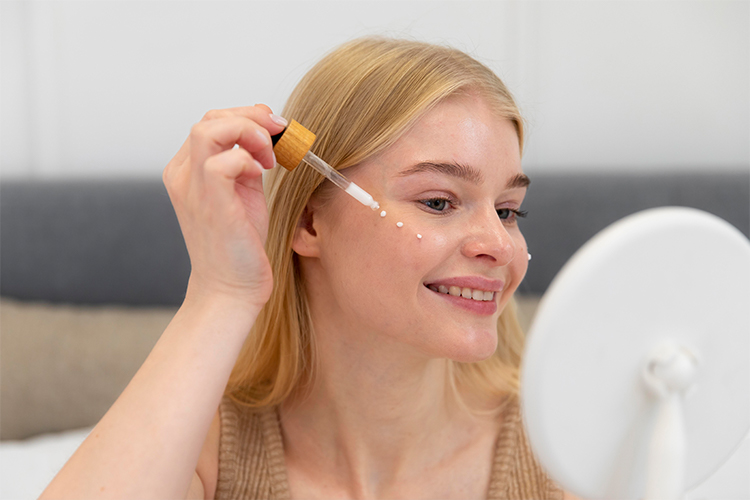
As we age, the skin begins to lose its elasticity. Over time, it becomes more vulnerable to fine lines and wrinkles. This volume loss leads to problems such as hollowness and sagging. When these issues arise, a person starts to look older and more tired, leading to dissatisfaction with their appearance in the mirror. In the fight against aging, many people turn to facelift and similar aesthetic procedures. The liquid facelift application, performed with dermal fillers and components like hyaluronic acid and calcium hydroxylapatite, yields highly successful results. This impressive treatment method is currently one of the most popular non-surgical facelift techniques. Your Medical Aesthetic Doctor, Dr. Lida Çiteli, has explained what you need to know before undergoing a liquid facelift for natural rejuvenation.
Which Injections Are Used in a Liquid Facelift?
For a liquid facelift, hyaluronic acid-based dermal fillers are applied to your skin. Hyaluronic acid is a molecule naturally produced by our body, with the ability to attract and bind water. Liquid facelift is an ideal application for reducing wrinkles. In addition to softening facial contours, hyaluronic acid also creates a tightening effect on the skin and stimulates the skin's elastin and collagen production. Products containing polycaprolactone and calcium hydroxylapatite promote collagen synthesis, providing long-lasting effects. It can be said that their volume effects are more limited compared to hyaluronic acid-based fillers. However, the duration of their results is longer. Nevertheless, you must ensure that your chosen clinic and doctor use reliable and high-quality brands. It is essential to avoid low-quality or counterfeit products on the market. You should not risk your health by being tempted by low prices.
Why Choose a Liquid Facelift?
As we age, our connective tissue, especially elastin and collagen in our skin, begins to break down faster. The reduction of fat in certain parts of the face causes us to acquire an increasingly hollow and tired appearance.
Liquid facelift is a treatment procedure that can reverse the aging process. It is largely possible to significantly improve early signs of aging with liquid facelift applications.
Dermal fillers work by filling the gaps in the skin. This helps the skin appear smooth and plump to a certain extent. They reduce wrinkles that appear on the skin surface. Furthermore, they allow us to improve the appearance in areas prone to sagging and hollowing, such as the cheeks and around the eyes. In summary, the goal of a liquid facelift procedure is to reduce the appearance of sagging and wrinkles on the skin. Additionally, it:
- Fills hollows in the cheeks.
- Reduces voids under the eyes.
- Minimizes the appearance of scars on the skin.
- Fills wrinkles around the lips, forehead, and eyes.
Ideal candidates for a liquid facelift are individuals with relatively minor and early-stage wrinkle and sagging concerns. If the extent of sagging has reached more severe levels or if you desire more dramatic results, you may consider surgical facelift procedures. You can contact your medical aesthetic doctor or dermatologist to learn the most appropriate treatment protocol for your needs.
What is the Difference Between Liquid Facelift and Traditional Facelift?
Traditional surgical facelift, much like the liquid facelift, is performed to rejuvenate the skin and reduce wrinkles. It has been a popular treatment procedure preferred by both male and female patients for many years. However, a traditional surgical facelift is an operation that typically lasts three to four hours. Surgical facelift is performed while the patient is under general anesthesia. Excess skin tissue is removed, and the skin is tightened. Additionally, tightening is achieved on ligaments and muscles.
However, surgical operations carry risks and difficulties. For those who wish to avoid these risks and difficulties, a liquid facelift is used as a less invasive method. This treatment, designed to address signs of aging in the skin, is mostly applied in the early stages of problems. The results of a liquid facelift procedure appear more natural. It is mostly applied to the jawline, face, and neck areas.
No incisions are made on the patient's body, and anesthesia is not required. It is a non-surgical, non-invasive treatment. Your doctor does not make any incisions during the procedure. Instead, small injections are performed with micro-needles. To ensure a more comfortable treatment experience for the patient, the area can be numbed with local anesthetic creams before the injections.
Do I Need a Liquid Facelift or a Traditional Surgical Facelift?
If you are unsure which of these two treatment options is the right solution for you, you should definitely consult your medical aesthetic doctor or dermatologist. However, in general terms:
Candidates suitable for traditional surgical facelift are:
- Individuals with no health problems that could hinder recovery.
- Those who do not use tobacco or similar products.
- Those seeking longer-term, permanent solutions.
- Those who want to achieve more definitive and impressive results.
Candidates suitable for liquid facelift treatment are:
- Those with initial and minor wrinkle and sagging problems.
- Those with no history of blood clotting.
- Those without issues such as heart disease or diabetes.
- Those who do not have any sensitivity to filler materials.
Liquid Facelift – Natural Rejuvenation with Biostimulation
The liquid facelift procedure is an application that stimulates the skin's natural regeneration processes. By eliminating the skin's loss of elasticity and providing tightening, the liquid facelift creates a lifting effect on the person's facial contours. Skin quality improves, resulting in a more vibrant, healthy, and firm skin appearance. Unlike dermal filler procedures that provide fullness, the liquid facelift acts by triggering the skin's own collagen production.
What is PLLA – SCA and How Does It Work?
PLLA – SCA is a type of biostimulator injected under the skin that stimulates fibroblast cells to support natural collagen production. Together with sodium carboxymethylcellulose, it ensures a more homogeneous distribution of PLLA in the skin and enhances its effect.



